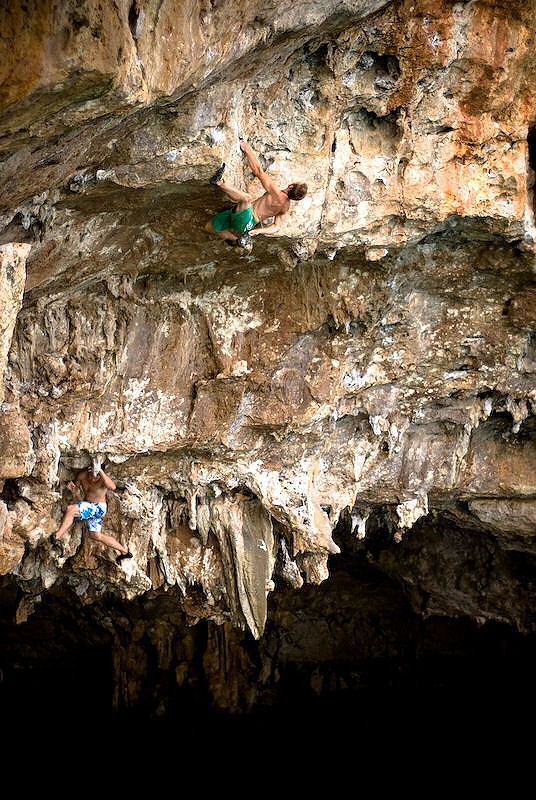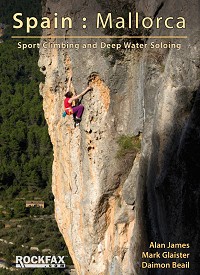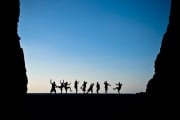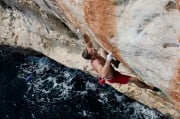Mallorca is the Spanish winter sun destination favoured by many Europeans. It has been described in the past as Spain's answer to the Greek island of Kalymnos.

For a long time Mallorca was primarily focused on sport climbing with early cardboard topo sheets creeping into the British bookshops in the mid-90s and Chris Craggs' small but popular Mallorca guide expanding upon this. Subsequent Rockfax guides followed, but all were focused on the island's popular and stunning sport climbing.
But as many of us know, the focus shifted slightly in 2005 when top American climber Chris Sharma made his groundbreaking first ascent of the Deep Water Solo (DWS) line of Es Pontas - rumoured to be 9a+, but unrepeated to date. With this stunning line the spotlight shifted with magazines, DVDs, TV and many websites drawing fresh eyes back to the island.
Deep Water Soloing is one of the purest forms of climbing. Solo climbing above the sea, which is intended to catch you if or when you fall. It's been practiced around the world since the late 70s and has grown increasingly popular especially with the explosion of DWS on the sea cliffs of Mallorca. It's a more advanced form of climbing, having higher demands on the physical and mental side, since it involves soloing even with the safety net of the sea.
Deep Water Solos are generally graded using the French sport climbing grading system with the addition of the S grade. The S grade stands for 'solo' of which four levels are used (S0 S3) to determine items like how clear your water entrance is, depth, heights of which you may fall etc. For an example of how this S grade may come into effect you could look at the UK DWS line of Freeborn Man, F6c, S1/2, a modern test piece for many aspiring UK climbers. The S1/2 translates into: the slight possibility of hitting a ledge low down (a jump back would avoid this) and the crux is higher up the wall, making the fall longer and more care is needed when bailing off and entering the water which needs to be done correctly from such a height. With this knowledge a climber knows what to expect and can adapt accordingly to climb the line safely.
For more information on S grades, check out any Rockfax guide containing DWS such as Mike Robertson's world climbing guide to DWS 'Deep Water' - Mike Robertson was one of the people who helped define the S grade all those years ago.
- You can also read Mikey's UKC Article: Getting in to Deep Water Soloing
Mallorca DWS...
Even though the ascent of Es Pontas stood out in most people's minds as to what Mallorca stood for regarding DWS, they couldn't be more wrong.
Prior to 2005, deep water explorers from around the world were unearthing the lost paradises of the east and west coasts. A rich vein of unclimbed lines were quickly picked off one by one. It began in the late 70s under the glare of the bright lights of the city of Palma. Miquel Riera took his bouldering obsession to the nearby sea cliff cave of Porto Pi and continued bouldering with the added safety net of the sea. Miquel Riera soon nicknamed it Psicobloc, a local term that still exists today.
Porto Pi although small became covered in gentle warm ups to powerful and bouldery 8bs. It soon became a great evening venue for city climbers on a warm summer evenings.
You would probably think Miquel's explorations, aided by Pepino Lopez, Xisco Meca, Pepe Link and Miki Palmer, would have flooded the island with epic lines, but sport climbing drew them away leaving the paradises of Mallorca a closely kept secret for years to come.
Porto Cristo - Cova del Diablo
In 2001 the Brits invaded. Well, guests of Miquel Riera to be fair, who emailed them a photo of him climbing at a then unknown crag in Porto Cristo. Neil Gresham, Tim Emmett, Mike Robinson, Ken Palmer to name but a few, armed themselves with hoards of climbing boots and chalk bags and set off to see for themselves what Diablo was all about. In addition to this army was the Austrian strong man and vocally energised Klem Loskot. They were escorted to what is now one of the most unique and spectacular DWS venues on earth, Cova del Diablo! This DWS jewel of the Mediterranean, with its perfectly placed jugs, crimps, tufas, and glistening warm Mediterranean sea had in the period of a week (under the watchful cameras and pens of the media) a total of twenty-six world class lines despatched.
The team's departure left behind a legacy of lines, chief of which was Loskot's prize possession 'Loskot And Two Smoking Barrels' which became the most sought after 8a+ on the island.
Tim Emmet left the best 7b jug fest, 'Afroman', which takes the steep and juggy terrain to half height where the line traverses left (not easily done) and leads to an easier exit. Ken Palmer's stamina fest, 'Superwoman' takes in the entire cove at various levels and is no easy picking at 7a+. To the far right of the crag is Mike Robertson's popular right-to-left traverse 5+ (originally done left to right) into the cove known as 'White Noise', which can, if one so desires, lead naturally into the jug-tastic 'Dogging Romp' 6a+. Neil Gresham apart from lines such as 'Ejector Seat' 7c and 'Iguanodon' 7b left the exhilarating DWS challenge of 'Calamares' 6b+, a grand line out of the right hand side of the 'Afroman Cave'.
Additionally on the other side of the bay of Porto Cristo lies the Tower of Falcons, a mega cave that originally only saw traverses and easier lines (ish) put up to the left of the cave back in 2001. Now the cave is home to the notorious 'La Hostia' 8a+ thanks to Chris Sharma, who ascended this line five years later in 2006.
Cala Barques
A year after the departure of the invasion force that took Diablo by storm, Toni Lamprecht and Klem Loskot arrived on a beautiful sandy beach covered with naked people tanning themselves. "What are we doing here?" they must have asked. But a short walk onwards answered their question. They where greeted by the astonishing DWS playground of Cala Barques. (If Diablo is a bit on the high side then this is for you, being a much lower venue in height that most people can easily get to grips with).
The first cave was dripping, not wet, but with tufas and stalactites. So like excited children on Christmas day Toni and Klem deployed their lines upon this magnificent cave. 'The Might of the Stalactite' 7a became the key to many of the trickier lines including Toni Lamprecht's 'Big XXL' a classic 7a which takes the dominant line through the cave. Today the favourite of most visitors getting to grips with this area is the final part of the 'Barques Traverse' 6b that takes the right hand side of the roof on buckets to the upper section of 'Big XXL'. Toni Lamprecht also added 'Golden Shower' 7a to the right of the cave area that is a fantastic mono crimp test on a slightly overhanging wall, that sees a lot of attention these days, and also a lot of splashdowns when things get tough.

The real secret gems of Cala Barques are just over the hill from this cave. Two additional caves can be found both of which lead to an amazing grotto. Three lines stand out here. Firstly the bucket-filled line of 'Bisexual', a great 7a that crosses the upper face of the cave via some outstanding moves. Secondly the more difficult 'Bandito' 7c, which attacks the cave roof on its right side, great for climbers wanting to push themselves not too high above the water. Finally in the right hand cave is the magical 'Strangers in Paradise' 7b, a great one to try in the evening sun.
This all leads to the grand battlefield of the infamous Tarantino Wall. Not a hugely popular area as the lines are quite intimidating, but should not be ignored if you are the head strong, stamina-efficient and competent soloer. 'Kill Bill' 2, a mighty 7c is the big prize here, along with Chris Sharma's mega roof problem 'Big Mamma' 8a+.
Today, people make themselves at home in the bay of Barques. Well, why not - classic climbing, a beautiful beach and a blue ocean lapping at your feet. But it needs to be said that camping here is not permitted, especially with its popularity increasing year on year. The government has been cracking down on campers and issuing warnings and fines so the best bet for you is to find alternative accommodation and fingers-crossed some local will open a camp site at some point.
Cala Sa Nau and Cala Mitjana
Further south from Cala Barques is Cala Sa Nau which is dominated by a large and steep cave, which is also home to Klem Lockots, 'Hupolup Kempf' 8b. This steep and stunning roof climb also brought with it Chris Sharma's 'Weather man' 8a+. Although this cave is an inspiring challenge and draws many a climbers attention it's no longer the draw of the area. The attention has moved to a smaller friendlier venue to the left of the cave. 'The Virgin Area' as it's commonly known is a good beginner's area with lots of lower grades to enjoy (4+ - 6a+). This area also has a small number of impressive harder lines such as 'Captain Black' and 'The attack of the spindly jellyfish', to play with, both of which are all around the 7a mark. If continuing south just over the hill and within easy walking distance from Cala Sa Nau you will find the bay of Cala Mitjana. Its main wall is home to such classics as 'Illuminations' 6b+ and 'New Forms' at the same grade. Additionally, around the corner is another small but excellent cave hosting the line of 'Rich Bitch' 7a, which is a fantastic jug puller.
Cala Marcal
Many who enjoy The Virgin Area at Cala Sa Nau and who are looking for the next step up tend to enjoy visiting the roadside crag of Cala Marcal. Although not as popular as its neighbouring Porto Colom, it's a great venue to tick some very worthwhile lines. 'Mortal Combat' 6b is a leaning tower of jugs and offers some 3 star climbing. Additional lines in the lower grades such as 'Lady Boys' 5+ and 'Higher than the Sun' 6a give this place a good afternoons worth of climbing.

Porto Colom
The Lighthouse Area is a deep water boulderer's paradise! With its treasure trove of problems and micro lines (most of which finish half way up the cliff), this venue gives you the freedom to try the harder more boulder-esque problems closer to the water. Headstrong climbers can continue to climb the upper walls of course but at a grade of 7a+ and not generally done by many. It's a popular hang out and the steep lowdown roof problems and powerful finishes keep many entertained for many trips. The easiest here is 'I Live In A Cave', a juggy (ish) 6b with some fine climbing leading to the ledge. Additionally is the 'Princess of Transylvania', Miquel Riera's classic 7a that tackles the roof in fine style to an exciting and strength-zapping finish.
Santanyi (DWS)
The magnificent Es Pontas arch stands alone amidst the waves like a petrified sea serpent. The mighty line of Es Pontas (unrepeated to date) crosses the belly of the whale and tops out on the seaward side of the arch. When the first topo of Es Pontas was released in 2007 additional unconfirmed lines were noted of which accuracy could not be determined. Even with Miquel's guide that came out in the same year it did not give the game away as there were some inaccuracies on his topos and a lack of information to make anything clearer. After Toni Lamprecht (who was a great help with DWS info with regards to the 2011 release of the Mallorca Rockfax guide book) and Chris Sharma's help, a new and accurate picture of the arch formed. The results were quite amazing, 8c's and 9a+'s do I need to say more? But on the left side of the arch was a line that caught people's attention. A 7b called 'Baby Sepia' which gives an arch challenge at a much more attainable grade!
Here's a section of the BigUp Productions film King Lines, which focuses on Sharma and Es Pontas... check out the dyno!
Missing video!
Additional DWS Crags
For further information on Mallorcas other DWS climbing area including Cala Serena and the west coast crags, then visit the Mallorca destination page over at DWSworld.com
Safety!
Climbing, as we all know is a dangerous sport and although the addition of water as a safety net is there in the event of a fall, DWS is not without its dangers. Always make sure you have your exit plan covered before you start climbing or enter the water. Sea conditions must be safe before you do anything, even a mild swell can make things tricky. Practise your water landings and try to pencil dive if falling from a height above 5m or so. Take note of the S grade, it's there for a reason and make sure the depth of the water is adequate. Finally, it goes without saying you need to be a good swimmer and use your common sense for everything you do. If you don't have any, then stay at home.
40 Essential Deep Water Solo Routes
Login as Existing User to subscribe, which will show the climbs you've already ticked.
Logistics
When to Go
The climbing season runs from late September to May. During this time if you pick the orientation and elevation of crags carefully the air temperature is usually ideal although in the depths of winter the mountain crags can be cold and Santanyi and Cala Magraner will be unbelievably hot on sunny days. Rainfall is not as low as on the mainland and at times can be persistent especially in the vicinity of the mountains to the north. After heavy rains seepage will affect some lines although the rock itself dries very quickly. Summer is very hot although the shady mountain crags will offer some possibilities.
Getting There
Palma is the main airport on the island and is the third largest airport in Spain so it accommodates flights from all over the world. The airport is home to a large number of car hire companies on site but it is always advisable to book ahead.
Accommodation Advertise here
No Premier Listings found in this area
There are many options all over Mallorca that range from small apartments to huge Villas. Palma itself is a very lively place and would suit those looking for a full night life. Soller is a quiet spot out of season. Puerto Pollensa is a very nice small coastal resort that has bars and restaurants that are open out of season. The resorts on the southeast coast are a long way from the bulk of the climbing areas and can be very quiet out of season.
Gear
For those only interested in single-pitch sport climbing a rack of 14 quickdraws and a 60m/70m rope is all that is needed. For the multi-pitch sport climbs an abseil device will be required. For the trad climbing a full rack, helmet and double ropes will be needed. It can get very warm and on some crags little shade can be had so a sun hat and sunscreen are well worth packing, as is a duvet for the occasional cold day in winter.
Outdoor Shops Advertise here
No Premier Listings found in this area
Food
Food on Mallorca is very easily obtained from the numerous shops and supermarkets that are located in virtually all of the island's towns. All tastes are catered for in the resorts although Mallorcan prices are generally higher than on mainland Spain. Restaurants on the smaller villages are likely to be shut on Mondays.
Other Activities
The beaches on Mallorca are legendary and the mountains are brilliant for walking. Road biking is extremely popular. The city of Palma is a very interesting place to visit whilst Soller has some good cafes.
Instructor/Guides Advertise here
No Premier Listings found in this area
Climbing Walls Advertise here
No Premier Listings found in this area

|
Sponsored Link |
||
Spain : Mallorca from ROCKFAXThe main guidebook to the climbing on the island for the last 20 years has been published by Rockfax and this 2016 edition adds to this legacy with another blockbusting volume for the sun-seeking climber. It covers the main sport climbing crags and deep water soloing venues across the island and is the only up-to-date book available. Sample chapter here. The book is also availble in full (with a few extras) on the Rockfax App. |




















Comments